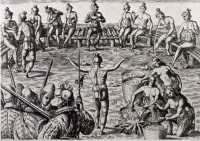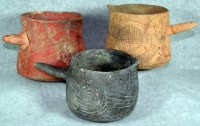 Europeans who traveled among the Native American tribes of the coastal southeast in the 16th and 17th centuries reported seeing them drink a dark, hot, heavily caffeinated beverage known as black drink, then vomiting it up. Brewed from the roasted leaves and bark of the Yaupon holly bush, black drink was served in shell cups and imbibed in massive quantities during important rituals like community decision-making, preparation for war or religious ceremonies. The drink itself probably wasn’t an emetic — the vomiting was a necessary step in the purification ritual, but it could have been a deliberate choice, or at most helped along by the sheer amounts of black drink quaffed — but the Europeans called Yaupon holly Ilex vomitoria because of its association with Native American heavy metal vomit parties.
Europeans who traveled among the Native American tribes of the coastal southeast in the 16th and 17th centuries reported seeing them drink a dark, hot, heavily caffeinated beverage known as black drink, then vomiting it up. Brewed from the roasted leaves and bark of the Yaupon holly bush, black drink was served in shell cups and imbibed in massive quantities during important rituals like community decision-making, preparation for war or religious ceremonies. The drink itself probably wasn’t an emetic — the vomiting was a necessary step in the purification ritual, but it could have been a deliberate choice, or at most helped along by the sheer amounts of black drink quaffed — but the Europeans called Yaupon holly Ilex vomitoria because of its association with Native American heavy metal vomit parties.
The shell cups have been found from Maryland to Florida to Texas, as one would expect, and even in distant societies like the pre-Columbian city of Cahokia, now outside of St. Louis, Missouri. The cups themselves are not evidence that the black drink traveled outside the Yaupon growing range as early as 1000 years ago, however, as the cups could have been traded as objects in their own right. A new study published in the Proceedings of the National Academy of Sciences proves that black drink did wind its way northwest hundreds of years before the New World was a twinkle in Spain’s eye.
Cahokia was an urban center with a population of 15,000 at its peak. Its downtown covered five square miles, and its defensive stockade was ingeniously designed to be taken down and rebuilt on a dime to reinforce areas under threat from an enemy. It was founded in 1050 A.D. and fell abruptly almost 300 years later. Archaeologists from the University of Illinois at Urbana-Champaign have excavated a number of colorful engraved ceramic vessels with a straight handle and a drinking lip from the Cahokia site. They found a black residue inside, but they could only confirm that the residue had traces of caffeine. Cacao also contains caffeine, but the residue didn’t match chocolate’s caffeine signature.
 Archaeologists Thomas Emerson and Timothy Pauketat from Urbana-Champaign and Patricia L. Crown, an anthropologist at the University of New Mexico in Albuquerque, enlisted the aid of W. Jeffrey Hurst of the Hershey Foods Technical Center in Pennsylvania. He’s the chocolate expert and biochemist who identified theobromine, the primary alkaloid of the cacao plant. Crown and Hurst analyzed the residue looking for theobromine and for ursolic acid, a compound found in the holly plants but not in chocolate. They found ursolic acid, thus proving that the Cahokians drank black drink as early as 1050 and no later than 1250 A.D.
Archaeologists Thomas Emerson and Timothy Pauketat from Urbana-Champaign and Patricia L. Crown, an anthropologist at the University of New Mexico in Albuquerque, enlisted the aid of W. Jeffrey Hurst of the Hershey Foods Technical Center in Pennsylvania. He’s the chocolate expert and biochemist who identified theobromine, the primary alkaloid of the cacao plant. Crown and Hurst analyzed the residue looking for theobromine and for ursolic acid, a compound found in the holly plants but not in chocolate. They found ursolic acid, thus proving that the Cahokians drank black drink as early as 1050 and no later than 1250 A.D.
Crown explains that because the bushes weren’t native to Cahokia but to the coastal region between eastern Texas and Florida, the leaves must have been brought to the inland city through trade routes connecting the two areas, which suggests the drink had huge cultural importance. Whether the Cahokians used black drink ritually isn’t known, but its appearance in fine-quality beakers suggests it was highly prized, if not sacred.
“We haven’t yet analyzed other types of pottery, so we can’t say that these beakers were for black drink exclusively,” Crown says. But the beakers were found at sites thought to be ritual gathering or burial places, and the distinctive handles, straight sides, and patterns are seen in pottery as far north as Wisconsin. If the beakers and black drink do go hand in hand, Crown and colleagues propose, it might signify wide-ranging Cahokian religious influence between the 11th and 13th centuries.
Is this the secret of Coca Cola? 🙂
I had no idea, at all, about anything stated in this post. You continue to introduce me to new things. The cups are really lovely, I wonder what they used for the glaze..the colors are quite strong.
WOW!